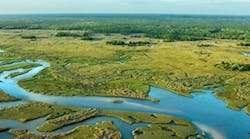Latest from Mike Weil
Can HVAC Be Fun? What About All the Eye Candy?
Welcome to our new AHR Expo Insider Coverage
How Did The HVAC Industry Do in 2013?
Just one year away: starting in April 2015, new water-efficiency standards will go into effect. Back in April 2010, U.S. Department of Energy (DOE) Secretary Steven Chu announced the finalization of higher energy efficiency standards for a key group of heating equipment that together will save consumers up to $10 billion and prevent the release of up to 164 million metric tons of carbon dioxide over 30 years.
These new standards will impact residential water heating systems, but that is by no means the end of the story. The Obama administration is focused not only on energy conservation, but water conservation as well. There is an intersting PDF you can download at http://bit.ly/H2ORules.
This focus is for one very good reason—in a word, drought. The U.S. has been suffering from low water conditions for decades, but the issue is becoming more acute with each passing year. As of August 2013, nine U.S. cities were in a state of severe water problems and that impacts not only potable water, but the water used in both residential and commercial HVAC applications as well.
The U.S. Environmental Protection Agency said in September 2013 that 36 states are facing local or regional water shortages and that by 2030, the demand for fresh water in the United States will exceed supply by as much as 40 percent.
And yet, few Americans seem concerned about or even aware of the issue.
HPAC Engineering contributor and green building consultant Jerry Yudelson, PE, MBA, LEED AP and co-author Ulf Meyer recently completed a book entitled, "The World’s Greenest Buildings: Promise vs. Performance in Sustainable Design. This large-scale study compares building performance data worldwide from the highest-rated large green buildings of the past 10 years, using actual energy and water operating data from 57 projects in 18 countries. It offers architects, engineers and project developers a new way to understand how high-performance buildings can be designed and constructed.
This is an excellent call to action for people worldwide on both the energy and water issues we face. In addition, Yudelson produced three videos on the coming crises:
Part 1. The Coming Water Crises
Part 2. Changing the Way We Build Buildings
Part 3. Taking Water Conservation Action
Meanwhile, in Massachusetts, the Massachusetts Water Resources Authority (MWRA) developed the Industrial, Commercial, and Institutional (ICI) Water Management Program to help state-based businesses, industries and institutions improve their water efficiency. This group has done a number of studies on water use and found that, in Massachusetts, 35 percent is used in cooling applications.
On its Website, MWRA provides some tips for better managing cooling towers, steam traps, boilers, and compressors. It even recommends replacing water-cooled equipment with air-cooled units where economically feasible.
In July 2013, HPAC Engineering Editorial Advisory Board member Larry Clark wrote a blog titled, “Water Matters!,” in which he highlights Florida’s efforts in water conservation.
He noted that the state has been identified by the Natural Resources Defense Council as one of five that are in danger of facing high-risk water shortages by 2050.
Clark wrote, “All of us in the industry recognize HVAC is a major consumer of energy, and we spend a lot of time and money trying to find ways to make equipment more efficient. But HVAC equipment doesn’t just use a lot of energy; it also can use a lot of water. For example, a 300-ton cooling tower can evaporate 12 to 13 gpm and, with typical drift and bleed rates, require 18 to 19 gpm in makeup water. And that makeup usually is potable water from the local utility.”
Even the mighty Colorado River isn’t immune. According to the Southern Nevada Water Authority, the Colorado River, which provides approximately 90 percent of Southern Nevada’s water supply, continues to experience serious and sustained drought conditions. As a result, Lake Mead’s water levels have dropped more than 100 ft. since January 2000, and Lake Mead is at less than half capacity. Water shortages and critical infrastructure outages are possible should these conditions persist.
The Denver Water utility requires all water used for evaporative or refrigerated cooling and air conditioning, including equipment such as condensers, and processes, to be recycled or reused.
New York City requires recirculated water for medium and large refrigeration and air-cooled systems; properties with steam-source refrigeration must use some condensate for cooling tower makeup water.
There certainly are many more examples of water-shortage issues and, as an industry, we can expect local, state, and the federal governments to begin upgrading and passing new regulations and ordinances to safeguard the water supply.
The question is, are you ready for these changes?
We’d love to hear about some of the water-use situations you’ve encountered in your work and about any rules/ordinances that impact mechanical-system design.
Share your stories and/or thoughts on this issue with us here by leaving a comment below, by contacting me directly, or by our social media email. We look forward to hearing from you.









